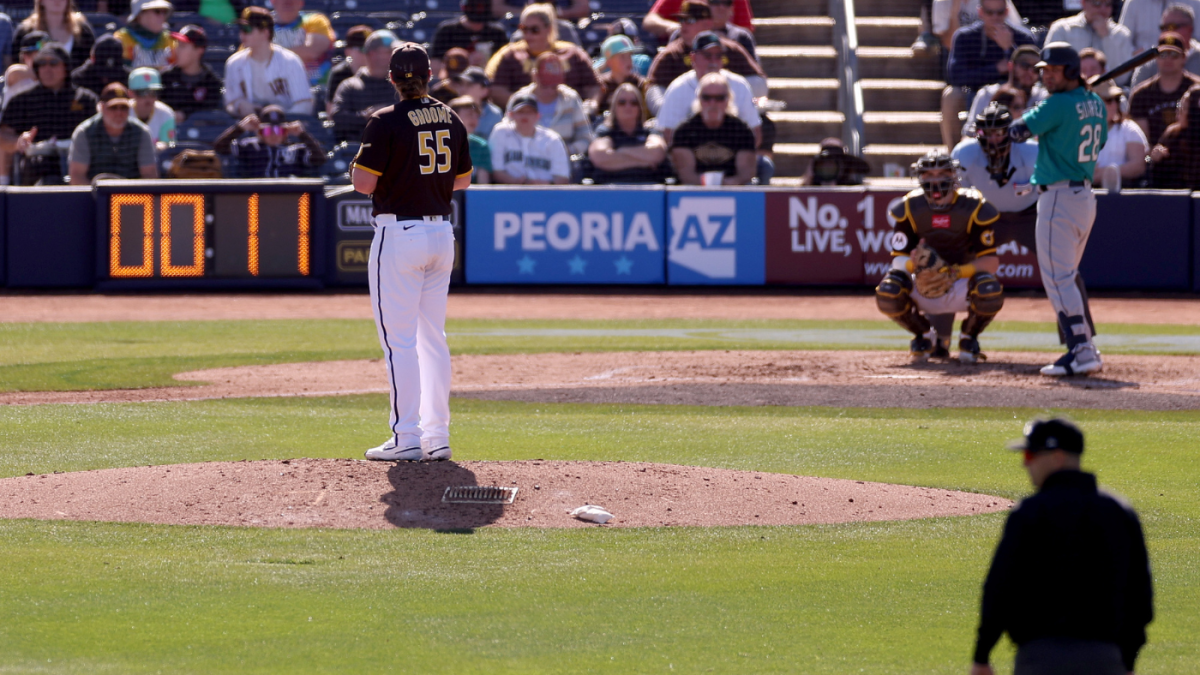
Freshly behind us is the first weekend of Cactus and Grapefruit League spring training games, and that occasioned a first look at the new rules in play for the 2023 Major League Baseball season. The early verdict is that it didn’t take long for said new rules to make a palpable difference.
For the uninitiated, here are those most notable new regulations:
- A pitch clock is now in place in the majors. Pitchers must begin their deliveries within 15 seconds when the bases are empty and within 20 seconds when one or bases are occupied. As well, the batter must be in the box and “alert” to the pitcher with at least eight seconds remaining on the pitch clock. Pitchers who violate will be charged a ball, and batters who run afoul will be docked a strike.
- Pitchers are allowed to “disengage” from the rubber just twice during each plate appearance, whether to step off or to make a pickoff throw. That tally resets if one or more runners advance during the plate appearance in question. Pitchers may make a third pick off attempt during a PA, but the runner will advance automatically if he’s not picked off on that third attempt.
- In addition to those pickoff throw limitations, baserunners are also benefiting from larger bases. The first-, second-, and third-base bags are now 18 square inches instead of 15. That makes for a bigger “target” for the baserunner, and it also shortens the distance between the stations. The distance between home and first and third and home is now reduced by three inches, and the distance between first and second and second and third is now 4.5 inches shorter.
- Infield overshifts are no more. Teams must have four fielders within the infield boundary whenever the pitcher is on the rubber, with two fielders stationed on either side of the second-base bag at the time of the pitch. Teams are still allowed to bring an outfielder in, either onto the infield or into the shallow outfield. They are not, however, permitted to use four outfielders.
When it comes to those positioning rules noted in the final bullet point above, it’s too soon to draw any conclusions about what impact they’ll have. However, in the case of the pitch clock, pickoff-throw limitations, and larger bases, we can indeed inspect the early returns for some takeaways. With the usual sample-size caveats along for the ride, here are those takeaways.
The pitch clock is making a difference
MLB under commissioner Rob Manfred has for some time been angling to reduce game times and whittle away at the “dead space” in games. The institution of the pitch clock at the highest level is the boldest step yet, and the first weekend of spring training games yielded promising results.
As Baseball America notes, spring training game times are thus far down significantly. In 2022 and 2021, spring game times were, respectively, in excess of and right at three hours. Thus far in 2023, spring games are averaging 2:39, which — high-level arithmetic forthcoming — is a reduction of more than 20 minutes from 2022 and 2021 levels. To cite one prominent example, the Royals and Mariners on Sunday combined for 15 runs and 25 hits but still managed to wrap up the contest in two hours and 25 minutes.
The real target, of course, is the regular season. Last year, regular-season games clocked in at 3:03 on average, and they’ve been at or in excess of the three-hour mark since 2011. If MLB manages to maintain carry over that current 2:39 run time into the regular season, that would be the lowest such regular-season figure since 1984.
Pitch clock violations are happening, and batters are also getting in on the act
Not surprisingly, there’s an adjustment period involved with the new pitch clock, which means violations. The relevant digits:
Predictably, pitchers are the main offenders, but batters on more than a few occasions have been dinged for not having their attention on the pitcher with at least eight seconds left on the clock. Padres’ third baseman Manny Machado made history by being the first major leaguer to be called for a pitch clock violation, and then on Saturday the Braves-Red Sox tilt resulted in a tie when Atlanta prospect Cal Conley was penalized in “walk-off” fashion for violating the clock:
Obviously no one but partisans of the beneficiary team want to see a game end like this, but this figures to be an exceedingly rare occurrence. We’re but toe-deep in spring training, and there’s plenty of time for pitchers and hitters to adapt to the clock and ingrain the hastened pace of their between-pitch liturgies. Big-league players are in partial measure selected for their capacity to adapt to changing conditions, and this is one of those. Similarly, most fans viewing at home are also going to adjust and will gradually forget that the pitcher-batter matchup is subject to a clock.
Steals are up
As noted above, MLB has attempted to increase structural base-running incentives. In the contemporary era, most teams have scaled back on the running game because cost-benefit analyses says they should. Most fans would agree that’s come at a cost in terms of entertainment, and MLB with the larger bases and limits on pick-off attempts is trying to make the stolen base a more rational gamble for teams. Thus far, it seems to be working. Via J.J. Cooper in that same Baseball America piece from above:
“Teams are averaging 1.08 steal attempts per game so far. That’s a nearly 40{18875d16fb0f706a77d6d07e16021550e0abfa6771e72d372d5d32476b7d07ec} increase, from .77 attempts per game in spring training in 2022. The success rate is also up. Last year in spring training, teams succeeded on 73{18875d16fb0f706a77d6d07e16021550e0abfa6771e72d372d5d32476b7d07ec} of attempts. This year the success rate is 78{18875d16fb0f706a77d6d07e16021550e0abfa6771e72d372d5d32476b7d07ec}.”
And the people rise and say as one: That’s more like it. In the realm of spring training that’s the highest level of stolen-base attempts since 2011. Of further note is that the current 1.08 attempts per game at a 78 percent rate of success comes to 0.84 successul steals per game. During the 2022 regular season, teams averaged a measly 0.51 steals per game, and in 2021 that figure was an even more galling 0.46 per game. If that 0.84 figure persists through the 2023 regular season, that would be highest stolen-base figure per team since 1987 — back when some but not all things were better. Before we get too enthralled by the running-game renaissance, it’s worth noting that stolen base attempts tend to be more frequent during spring training when compared to the regular season. Still, we’ll take it.
It bears repeating that these are very early trends that are subject to change. However, there’s some “stickiness” to things like game time and base-running trends even in small samples. “So far, so good” has to be the initial takeaway for advocates of these changes.








